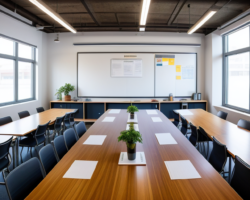Working from home has become the new normal for many of us, but it’s not without its challenges. One of the most significant issues is dealing with the constant noise and distractions that can disrupt our work. Whether it’s the sound of traffic outside, the TV in the next room, or the kids playing in the backyard, creating a peaceful and quiet workspace is essential for productivity and focus. In this blog post, we’ll discuss practical tips for building a soundproof home office. From assessing the noise sources in your home to choosing the right building materials and incorporating acoustic panels and soundproof curtains, we’ll cover all the essentials for creating a quieter and more productive workspace. So, if you’re tired of being constantly interrupted by outside noise, read on for expert advice on how to transform your home office into a peaceful oasis.
Assessing the Noise Sources in Your Home
When it comes to creating a peaceful and quiet living space, the first step is to identify the noise sources in your home. Many homeowners underestimate the impact of various noise sources on their overall well-being, but taking the time to assess and address these issues can make a significant difference in the comfort and tranquility of your home.
Start by taking note of the most common noise sources such as traffic from outside, loud neighbors, appliances, pets, and creaky floors. Pay particular attention to the times of day when these noise sources are most intrusive in order to better understand the extent of the issue.
Once you have identified the noise sources, consider how the sound is traveling and where it is most pronounced within your home. Are there specific rooms or areas that are more affected by the noise? This will help you determine where to focus your efforts in terms of soundproofing and noise reduction.
Remember that assessing the noise sources in your home is the first step in creating a more peaceful and comfortable living environment. By understanding the specific noise sources and how they affect your home, you can take targeted steps to address and minimize the impact of these disturbances, ultimately leading to a quieter and more enjoyable living space.
Choosing the Right Location for Your Office
When it comes to setting up a new office, one of the most crucial decisions you’ll have to make is choosing the right location. The location of your office can have a significant impact on the success of your business, as it can affect employee morale, productivity, and even your bottom line.
It’s important to consider factors such as commute times for your employees, accessibility for clients, and the overall atmosphere of the area. The location should be convenient for both your employees and clients, with easy access to public transportation and parking facilities.
In addition, you should also think about the overall atmosphere of the location. Is it a bustling downtown area with lots of foot traffic and potential customers, or is it a quiet suburban neighborhood that offers a more peaceful work environment? Consider the nature of your business and the type of clients you serve when choosing the right location for your office.
Furthermore, you should also take into account the cost of the location. While a prime downtown office space may seem ideal, it could come with a hefty price tag. Consider your budget and weigh the pros and cons of each potential location before making a final decision.
Choosing the Right Building Materials
When constructing a new home or renovating an existing one, it is important to focus on choosing the right building materials to ensure a comfortable and peaceful living environment. The selection of materials for walls, floors, and ceilings plays a crucial role in minimizing noise transmission and creating a soundproof home.
One of the most important factors to consider when choosing the right building materials is their sound-insulating properties. Opting for materials with high sound transmission class (STC) ratings can effectively reduce the impact of external noise and enhance overall acoustic comfort within the home. Additionally, materials with high noise reduction coefficients (NRC) can minimize reverberation and echo, contributing to a quieter indoor environment.
Choosing the right building materials also involves considering their density and mass. Heavier and denser materials, such as concrete, brick, and mineral wool, are effective at blocking sound waves and preventing noise from traveling between different spaces. It is essential to carefully evaluate the density of materials to determine their potential for soundproofing applications.
In addition to sound insulation properties, it is important to prioritize the durability and sustainability of building materials. Opting for eco-friendly and durable materials not only contributes to a healthier living environment but also reduces the need for frequent maintenance or replacements, offering long-term cost savings and environmental benefits.
Sealing Gaps and Cracks in the Walls
Sealing gaps and cracks in the walls of your home is crucial for minimizing the amount of noise that enters your living space. Gaps and cracks allow sound to easily travel through the walls, disturbing your peace and quiet. To effectively soundproof your walls, you must first identify all the gaps and cracks that exist.
Once you have identified the areas that need attention, it’s important to choose the right sealing materials to fill in the gaps and cracks. This can include using acoustic caulk or foam sealant to ensure that all openings are completely sealed. Additionally, you may need to use weatherstripping around doors and windows to prevent sound from seeping in through those areas.
After sealing the gaps and cracks, it’s essential to test the effectiveness of your efforts. One way to do this is by standing inside the room and having someone make noise outside. If you notice a significant reduction in the sound level, then your sealing efforts have been successful.
By taking the time to seal gaps and cracks in your walls, you can create a more peaceful and quiet environment within your home.
Installing Soundproof Windows and Doors
When it comes to achieving a quiet and peaceful living environment, one of the most effective solutions is installing soundproof windows and doors. These specialized windows and doors are designed to block out noise from the external environment, creating a more serene indoor setting.
Soundproof windows and doors are typically constructed with multiple layers of glass, as well as insulating materials to reduce the transmission of sound waves. This not only helps to minimize the impact of outside noise, but also enhances energy efficiency and thermal insulation.
When considering the installation of soundproof windows and doors, it’s important to consult with a professional to determine the most suitable options for your specific needs. Factors such as the location of your home, the level of noise pollution, and your budget will all play a crucial role in choosing the right products.
Additionally, proper installation is key to ensure the effectiveness of soundproof windows and doors. Working with experienced contractors or technicians will guarantee that the products are installed correctly, maximizing their noise-reducing capabilities.
Using Soundproofing Techniques for Floors and Ceilings
When it comes to creating a quiet and peaceful environment in your home or office, soundproofing techniques for floors and ceilings are essential. By reducing the transmission of sound from one room to another, you can enjoy a more comfortable and productive space.
One of the most effective ways to soundproof your floors and ceilings is by installing acoustic underlayment. This special type of underlayment is designed to absorb and reduce the transmission of impact and airborne noise. By placing it beneath your flooring or above your ceiling, you can significantly reduce the amount of sound that travels between rooms.
Another popular soundproofing technique for floors and ceilings is the use of soundproofing mats or panels. These products are designed to block and absorb sound waves, reducing the amount of noise that passes through the floor or ceiling. By strategically placing these mats or panels, you can create a quieter and more peaceful environment.
Additionally, incorporating soundproofing insulation in the floors and ceilings can also help to reduce noise transmission. Special types of insulation are designed to absorb and dissipate sound waves, providing a more soundproof barrier between rooms.
Incorporating Acoustic Panels and Soundproof Curtains
When it comes to creating a peaceful and quiet environment in your home, incorporating acoustic panels and soundproof curtains can make a significant difference. These two elements work hand in hand to absorb and block out unwanted noise, creating a more enjoyable and relaxing living space.
Acoustic panels are designed to reduce noise levels by absorbing sound waves. They are typically made from specialized materials that are dense and thick, allowing them to effectively dampen sound. These panels can be strategically placed on walls or ceilings to minimize the transmission of noise between rooms or from external sources.
Soundproof curtains, on the other hand, are an easy and practical solution for minimizing noise from entering or exiting a room. These curtains are typically made with multiple layers of dense fabric that act as a barrier to sound waves. They are especially useful for blocking out external noise from traffic, construction, or neighbors, allowing you to enjoy a quieter and more peaceful living space.
When incorporating acoustic panels and soundproof curtains into your home, it’s important to consider the specific areas where noise is most disruptive. Whether it’s the living room, bedroom, or home office, these elements can be strategically positioned to effectively reduce unwanted noise and create a more tranquil environment for relaxation or productivity.





